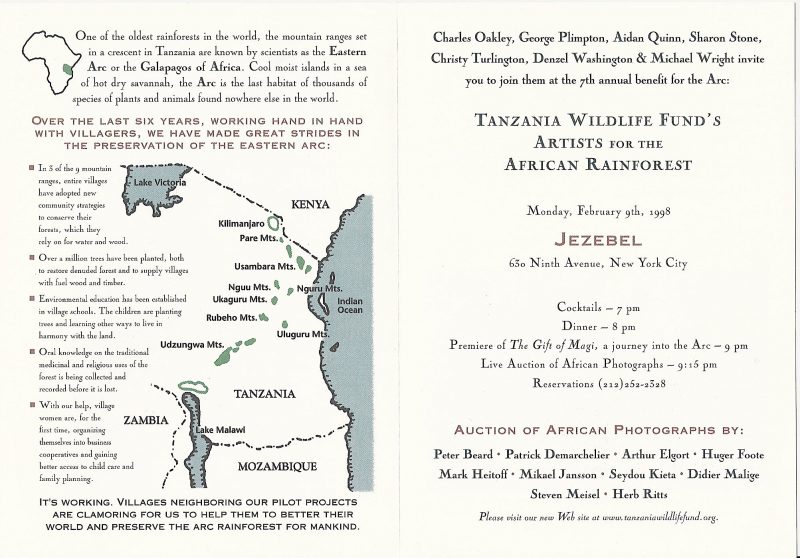SOLD. Peter Beard Fundraiser Invitation Card, New York, 1998
Peter Beard Fundraiser Invitation Card, “Tanzania Wildlife Fund’s Artist for the African Rainforest”, Monday, February 9th, 1998, at Jezebel, New York (see photos for sull details).
‘Loliondo Lion Charge’ famous cover photograph by Peter Beard. Back cover is of Peter Beard & Christy Turlington.
Card measures 5 x 7 inches closed and 7 x 10 inches opened. Excellent condition.
Asking USD$95.
SOLD.
Peter Beard, Wildlife Photographer on the Wild Side, Dies at 82
Called “the last of the adventurers,” Mr. Beard photographed African fauna at great personal risk, and well into old age could party till dawn. He had been missing for 19 days.

Credit: Gerard Malanga
Peter Beard, a New York photographer, artist and naturalist to whom the word “wild” was roundly applied, both for his death-defying photographs of African wildlife and for his own much-publicized days — decades, really — as an amorous, bibulous, pharmaceutically inclined man about town, was found dead in the woods on Sunday, almost three weeks after he disappeared from his home in Montauk on the East End of Long Island. He was 82.
His family confirmed that a body found in Camp Hero State Park in Montauk was that of Mr. Beard.
He had dementia and had experienced at least one stroke. He was last seen on March 31, and the authorities had conducted an extensive search for him.
“We are all heartbroken by the confirmation of our beloved Peter’s death,” the family said in a statement, adding, “He died where he lived: in nature.”
Mr. Beard’s best-known work was the book “The End of the Game,” first published in 1965. Comprising his text and photographs, it documented not only the vanishing romance of Africa — a place long prized by Western colonialists for its open savannas and abundant big game — but also the tragedy of the continent’s imperiled wildlife, in particular the elephant.
Peter Beard, “The End of the Game”

In later years, Mr. Beard became famous for embellishing his photographic prints with ink and blood — either human (his own) or animal (from a butcher) — yielding complex, cryptic, multilayered surfaces.
He was also known for the idiosyncratic, genre-bending diaries that he had kept since he was a boy — profuse assemblages of words, images and found objects like stones, feathers, train tickets and toenail clippings — and for the large, even more profuse collages to which the diaries later gave wing.
But as renowned as he was for his work (he received solo exhibitions at the International Center of Photography in Manhattan, the Centre National de la Photographie in Paris and elsewhere), Mr. Beard remained at least as well known for his swashbuckling, highly public private life.
Even by the dashing standards of wildlife photography, his résumé was the stuff of high drama, full of daring, danger, romance and tall tales, many of them actually true. Had Mr. Beard not already existed, he might well have been the result of a collaborative brain wave by Hemingway, F. Scott Fitzgerald and Paul Bowles.
He was matinee-idol handsome and, as an heir to a fortune, wealthy long before his photographs began selling for hundreds of thousands of dollars apiece.
Besides documenting Africa’s vanishing fauna, he photographed some of the world’s most beautiful women in fashion shoots for Vogue, Elle and other magazines. He had well-documented romances with many of them, including Candice Bergen and Lee Radziwill, the sister of Jacqueline Kennedy Onassis.
“The last thing left in nature is the beauty of women, so I’m very happy photographing it,” Mr. Beard told the British newspaper The Observer in 1997.
He discovered one supermodel, Iman, and spun a fabulous legend about her origins. He was married for a time to another, Cheryl Tiegs.


